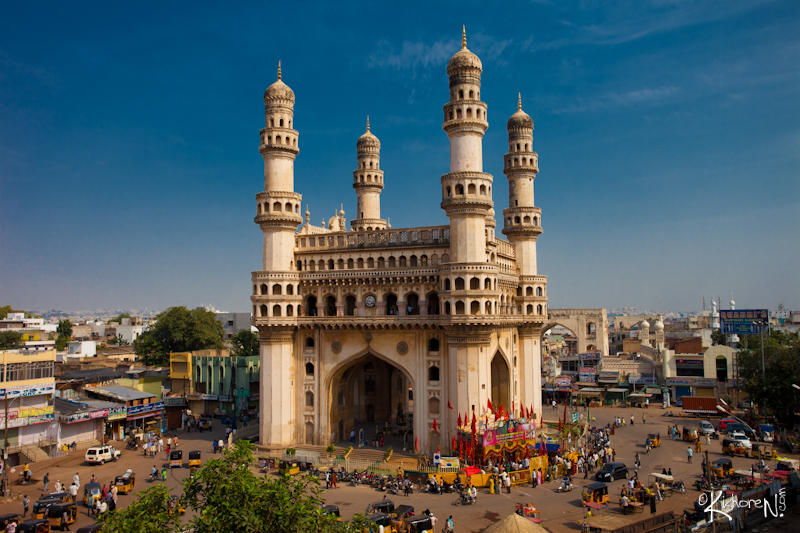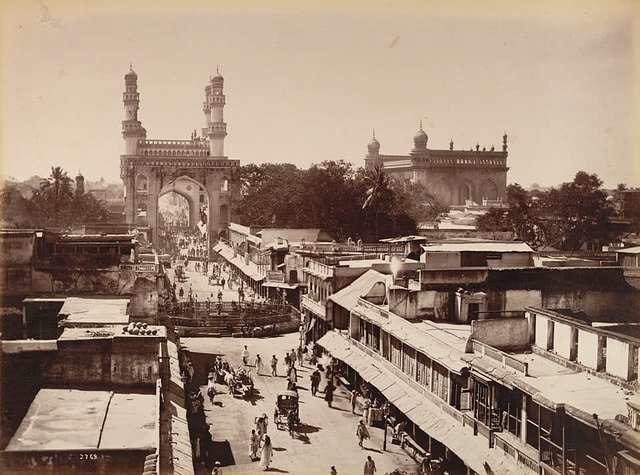The most famous building in Hyderabad, also known as the "Arc de Triomphe of the East," the Charminar was constructed to commemorate the end of the cholera epidemic that had decimated the city in the sixteenth century.
Located on the east bank of the Musi River, with Makkah Masjid to the south-west and the Laad Bazaar to the west, Charminar is a significant cultural and historical site in India that is known in Urdu as "four minars," or pillars. A first-time visitor's tour of the Nizam city wouldn't be complete without experiencing the contagious excitement of the location where it all started, namely Charminar.
Tourism in India in 2024 would be incomplete if you don't visit Charminar in Hyderabad, often called the heart of Hyderabad.
What the Taj Mahal is to Agra, or the Eiffel Tower to Paris, the Charminar is that to Hyderabad. With its four minarets and open arches, this majestic monument-turned-mosque has been around for more than 400 years, making it the best representation of the city's architectural and historical past.
Situated in the center of Hyderabad, a bustling marketplace encircles it and is a popular destination for tourists. As you leave your Hyderabad hotel for a sightseeing tour, you should definitely check out the Charminar.


Charminar: History and Legacy
The name in English is derived from the Urdu words chār and minar or meenar, which mean "Four Pillars". These towers are intricate minarets connected and upheld by four majestic arches.
The fifth Sultan of the Qutb Shahi dynasty, Sultan Muhammad Quli Qutub Shah, built the Charminar more than 400 years ago.
When Hyderabad was a freshly founded city in 1591, he moved his capital from Golconda to begin construction of this magnificent mosque.
The Golconda fort, constructed in the 16th century, is the oldest Qutb Shahi structure still standing in Hyderabad.
Two significant landmarks from this era are the Charminar and Mecca Masjid, which were both commissioned by Mohammed Quli Qutb Shah, the city's founder.
The reason Qutub Shah built this enormous mosque in the center of his new capital is the subject of multiple theories. Some historians claim that the cholera epidemic that was killing thousands of the Sultan's subjects at the time drove him to move his capital.
He prayed to God and promised that if his people's suffering ended, he would build a mosque. When the city was free of cholera, the Charminar was constructed to remember this promise.
According to a different school of thinking, Quli Qutub Shah built the mosque and established Hyderabad to commemorate the beginning of the second Islamic millennium, which was a momentous occasion for the Islamic community at the time. The building was given the name Charminar, which translates to "Four Towers" in Urdu because of each of its four towering minarets.
Peek into the history of the Gateway of India and its importance for the British Empire.
Charminar Architecture
Designed by Mir Momin Astarawadi, an Iranian architect residing in Hyderabad, the imposing structure showcases the Indo-Islamic architectural style, which draws inspiration from Persian architecture. The structure weighs over 14,000 tons and is constructed out of crushed marble, granite, limestone, and mortar.
Iranian architect Mir Momin Astarabadi created the distinctive Indo-Saracenic style monument, with its recognizable appearance being enhanced by four minarets.
Each side of the monument measures 20 meters (66 feet) and is adorned with a grand arch.
The structure of the Charminar is precisely square in shape and measures 20 meters on each side. The monument has a unique appearance thanks to its four large arches and four beautiful minarets positioned at each of its four corners. Each of the four-story, 56-meter-tall minarets includes a double balcony, a top dome, and other embellishments. A bird's-eye perspective of the city and the adjacent marketplace can be obtained by climbing the 149 steps to the monument's upper floor.
The Charminar has ornate balconies and balustrades, as well as stucco ornamentation. On a section of the building's exposed roof is a mosque as well. During Sultan Qutb Shahi's reign, a portion of the Charminar's roof was used as a mosque, and the remaining space was used to house the court.
Travel to India's seat of political power and unravel the history of the Red Fort.
Legacy of Charminar
Not only is the Charminar one of the most popular historical sites in Hyderabad, but it's also one of the nation's most well-known structures. It is encircled by a bustling marketplace known as Chudi Bazar, often spelt Laad Bazar, where the energy of the city is palpable. Even now, the ancient mosque atop the Charminar continues to be in use. This famous monument celebrates a number of festivals, such as Eid-ul-Fitr and Eid-ul-Adha.
Every nightfall, the Charminar is briefly illuminated, creating a breathtaking picture when set against the pitch-black sky. The Archeological Survey of India, in charge of overseeing the monument and providing for its upkeep, has classified the building as an archaeological and architectural treasure. The provisional list of UNESCO World Heritage Sites now includes the Charminar.
The building has a history as old as Hyderabad itself, and although it has withstood the test of time, it has also sustained some damage and repairs. Lightning struck the southwest minaret during the governorships of Asaf Jahi and Qutb Shahi, although it was later restored. In 1824, a new layer of plaster was applied to the monument, at an estimated expense of one lakh rupees. The sixth Nizam of Hyderabad, Mir Mahboob Ali Khan, adorned the four arches in 1889 with four clocks that he had brought from London.

Discover the towering glory that is the Qutab Minar through a historical lens.
Charminar: Interesting Facts about the Heritage Building
- Due to its equally stunning architecture as the well-known Arc de Triomphe in Paris, the Charminar is sometimes referred to as the "Arc de Triomphe of the East."
- As per prevailing views, the four minarets of the Charminar were constructed to symbolize the four Islamic prophets or khalifas.
- The Golconda Fort and the Charminar are thought to be connected by an underground tunnel that was intended to serve as the royal family's escape route in the event that the city was besieged. But no one knows where the tunnel is located.
- In 2010, Lindt chocolatier Adelbert Boucher used chocolate to make a fifty-kilogram copy of this amazing monument as a tribute.
- During his invasion of the city in 1687, the Mughal Emperor Aurangzeb ordered the destruction of most of the buildings, but he spared the Charminar because of the mosque on its upper floor.
- The Charminar Express is a train that runs between Chennai and Hyderabad and is named after the Charminar.
- The Charminar is depicted on the Telangana state emblem.
Revel in the history of the Ajanta Caves and celebrate India's cultural diversity.
Charminar: Tourist Information
Charminar is well-known for a variety of things, but its mouthwatering cuisine and excellent deals are its main draws. The vicinity of the Charminar is the best region in Hyderabad for shopping.
At all times, the streets are full of people, and the shops are filled with eye-catching, vibrant jewellery and bangles. Known for its 'Chudi Bazaar,' or 'Market of Bangles,' the market surrounding Charminar is a constant source of excitement. Here, you may indulge in the real "Hyderabadi Biryani," get the brightest jewels, and enhance your appearance with the traditional "Soorma," which is created in Hyderabad. This is the ideal location for roadside dining while you stuff your shopping bags full of tiny things.
Trace India's spiritual roots with a history of the Khajuraho temples.
Google Reviewer
Google Review Of Charminar
The monument stands tall among the hustle and bustle of the place. However the place is very hard to access, the entire area is overcrowded with people and hawkers. It is a sad sight to see that the government has done nothing to keep the area clear around a historical monument. Probably the best time to visit is early morning or midnight when there is no crowd. Heard that Sunday nights are also less crowded. Go to the area if you enjoy the crowds (Note: no parking here)
Trip Advisor
Trip Advisor Review
Charminar is the heart of Hyderabad. Charminar looks in the night very amazing and beautiful. Char Nar Biryani is very tasty. A fantastic structure. Ab it crowded as we went on a weekend. Also, we climbed up to the top of it. The steps are steep and a bit congested while climbing and getting down.
Charminar Ticket Information
The Charminar ticket price for Indian travelers and those from SAARC and BIMSTEC countries is INR 25. However, the entry ticket for foreigners is INR 300.
Entry is free for children under the age of 15.
Attractions in Charminar
Lad Bazaar
It is estimated that 14,000 businesses were located in this Charminar market during the Qutb Shah era. Even today, other than jewellery, silks, spices, perfume oil, incense, and other trinkets, Lad Bazaar, now known by its more well-known name, Charminar Market, is the place to go to in Hyderabad to find gorgeous glass and lac bangles. There are lots of Irani tea kiosks where you may stop and relax after all the walking.
Marvel at India's architectural glory through a history of the Ellora Caves.
Makkah Masjid
Ascend to the top of the Charminar's first floor for a bird's-eye perspective over the city, and while you're there, take in views of Makkah Masjid, another significant Qutb Shahi structure. This opulent mosque was commissioned by Muhammad Quli Qutb Shah and features bricks made from the soil of Mecca, the holiest place in Islam, in its central arch.

Travel back in time to the majestic Konark Sun Temple in Odisha.
Char Kaman and Gulzar Houz
Four arches, sometimes referred to as Char Kaman, Charminar Kaman, Kali Kaman, and others, were constructed in the 16th century alongside the Charminar. Gulzar Houz is the name of the fountain located in the center of Char Kaman.
Bhagyalakshmi Temple
A tiny temple known as "Bhagyalakshmi Temple" sits at the foot of the Charminar and has long been the subject of debate. There have been disagreements about the temple's age, defying the irony that it is located near one of the most important Islamic sites. In 2012, an image was published in the Hindu newspaper with the caption, "The temple is not as old as the Charminar." Claiming to be a relatively new building, it was made abundantly evident that the 1957 and 1962 photos of the Charminar did not feature any temple. Situated at the foot of the luxurious Charminar, the Bhagyalaskmi Temple is a fascinating small temple that may be a recent addition or an earlier one.
Need assistance understanding the material in your geography class? Find a great tutor on Superprof to help!















